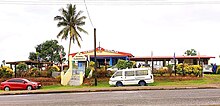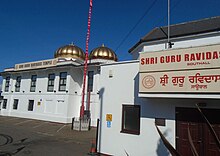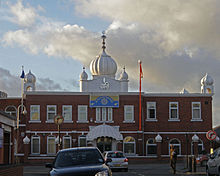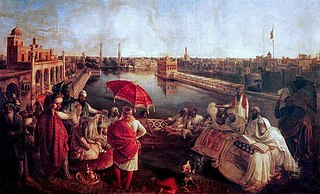
Sikhs are an ethnoreligious group who adhere to Sikhism, a religion that originated in the late 15th century in the Punjab region of the Indian subcontinent, based on the revelation of Guru Nanak. The term Sikh has its origin in the Sanskrit word śiṣya, meaning 'seeker', 'disciple' or 'student'. According to Article I of Chapter 1 of the Sikh Rehat Maryada, the definition of Sikh is: Any human being who faithfully believes in
- One Immortal Being
- Ten Gurus, from Guru Nanak Sahib to Guru Gobind Singh Sahib
- The Guru Granth Sahib
- The utterances and teachings of the ten Gurus and
- The initiation, known as the Amrit Sanchar, bequeathed by the tenth Guru and who does not owe allegiance to any other religion, is a Sikh.

Vaisakhi, also known as Baisakhi, marks the first day of the month of Vaisakh and is traditionally celebrated annually on 13 April and sometimes 14 April. It is seen as a spring harvest celebration primarily in Punjab and Northern India. Whilst it is culturally significant as a festival of harvest, in many parts of India, Vaisakhi is also the date for the Indian Solar New Year.

Anandpur Sahib, also referred simply as Anandpur, is a city in Rupnagar district (Ropar), on the edge of Shivalik Hills, in the Indian state of Punjab. Located near the Sutlej River, the city is one of the most sacred religious places in Sikhism, being the place where the last two Sikh Gurus, Guru Tegh Bahadur and Guru Gobind Singh, lived. It is also the place where Guru Gobind Singh founded the Khalsa Panth in 1699. The city is home to Takhat Sri Kesgarh Sahib, the third of the five Takhts in Sikhism.
Ravidassia or the Ravidas Panth is a religion based on the teachings of Guru Ravidas. It was considered a sect within Sikhism until 2009. However, some Ravidassias continue to maintain Sikh religious practices, including the reverence of the Guru Granth Sahib as their focal religious text, wearing Sikh articles of faith (5Ks), and appending Singh or Kaur to their names.
The Sikh Light Infantry is a light infantry regiment of the Indian Army. The regiment is the successor unit to the 23rd, 32nd and 34th Royal Sikh Pioneers of the British Indian Army. The regiment recruits from the Sikh community of Himachal Pradesh, Punjab and Haryana states of India.
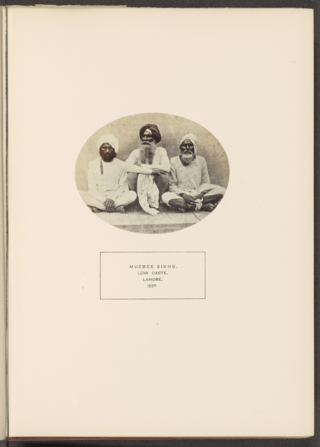
Mazhabi Sikh is a community from Northern India, especially Punjab region, who follow Sikhism. Mazhabi are part of wider category of Sikhs, who convert from the hindu rangrette. The word Mazhabi is derived from the Arabic term mazhab, and can be translated as the faithful. They live mainly in Indian Punjab, Rajasthan and Haryana.

Bhagat Sadhna, also called Sadhna Qasai, was a north Indian poet, saint, mystic and one of the devotees whose hymn was incorporated in Guru Granth Sahib. Venerated in the region of Punjab, among Sikhs and Ravidassias, his devotional hymn is widely quoted by most preachers. His one hymn is present in Adi Granth Sahib, in Raga Bilaval.
Sukhdev Singh Libra, was an Indian politician and Member of Parliament.

Indian Sikhs number approximately 21 million people and account for 1.7% of India's population as of 2011, forming the country's fourth-largest religious group. The majority of the nation's Sikhs live in the northern state of Punjab, which is the only Sikh-majority administrative division in the world.
Unlike the majority of Fiji's Indian population, who are descendants of Indian indentured labourers brought to Fiji between 1879 and 1916, most of the Sikhs came to Fiji as free immigrants. Most Sikhs established themselves as farmers. Sikhs also came to Fiji as policemen, teachers and preachers. In recent years large numbers of Sikhs have emigrated from Fiji, especially to the United States, Canada, the United Kingdom, Australia and New Zealand. Sikhs in Fiji are generally referred to as Punjabis.

Shri Guru Ravidas Janam Asthan Mandir, located in Seer Goverdhanpur, Varanasi, Uttar Pradesh, India, is an important cultural and religious site for Dalits, Ravidasis, and Ramdasia Sikhs. It was built to mark the birthplace of Ravidas. Millions of devotees gather there for Ravidas's birthday each year.

Ravidas or Raidas (1267–1335) was an Indian mystic poet-saint of the Bhakti movement during the 15th to 16th century CE. Venerated as a guru in the modern regions of Uttar Pradesh, Bihar, Rajasthan, Gujarat, Maharashtra, Madhya Pradesh, Punjab, and Haryana, he was a poet, social reformer and spiritual figure.

Dutch Sikhs form a religious minority in the Netherlands. They number around 15,000 and most of them live in or around Amsterdam. There are nine gurudwaras in the Netherlands.

Dera Sach Khand Ballan, also known as Dera Sant Sarwan Dass or Dera Ballan, is a Ravidassia dera based in the village of Ballan near Jalandhar, Punjab, India. It was founded by Pipal Dass soon after 1900, and it played a role in the Ad Dharm movement to popularize the image of Ravidas as a guru. It has since adopted the mission of spreading the teachings of Ravidas and advancing public education and healthcare in India.

Talhan is a village in Jalandhar district, near the Jalandhar Cantonment, in Punjab, India.
The Ad-Dharmi is a sect in the state of Punjab, in India and is an alternative term for the Ravidasia religion, meaning Primal Spiritual Path. The term Ad-Dharm came into popular usage in the early part of the 20th century, when many followers of Guru Ravidas converted to Sikhism and were severely discriminated against due to their low caste status. Many of these converts stopped attending Sikh Gurdwaras controlled by Jat Sikhs and built their own shrines upon arrival in the UK, Canada, and Fiji Island.Ad-Dharmis comprise 11.48% of the total of Scheduled Caste communities in Punjab.
Khuralgarh Sahib is one of the most prominent historical place of Ravidasi communities like Ad-Dharmi, Chamar, Ramdasia Sikhs and Mochis. It is situated at village Kharali, Garhshanker, Hoshiarpur district. Khuralgarh Sahib is also called Charan Choh Ganga Sri Guru Ravidas Ji as this place was visited by Sri Guru Ravidas
Sir Gobardhan is a census town in Varanasi tehsil of Varanasi district in the Indian state of Uttar Pradesh. The census town & village falls under the Shir Goverdhanpur gram panchayat. Sir Gobardhan Census town & village is about 13 kilometers South of Varanasi railway station, 323 kilometers South-East of Lucknow and 3.5 kilometers South-East of Banaras Hindu University main gate. It is of historical significance as it is birthplace of Sant Sri Guru Ravidas. Shri Guru Ravidass Janam Asthan at Seer Goverdhanpur is main pilgrimage place for Ravidasis worldwide.

Shri Guru Ravidas Gurughar, Tughlakabad is one of the important religious places of Ravidasi communities like Ad-Dharmis, Ramdasia Sikhs, Chamars, Jatavs, and Mochis. It is situated at Tughlakabad area of Delhi, India.
Chambhar is caste from Indian state of Maharashtra, and Northern Karnataka. Their traditional occupation was leather work. Historically subject to untouchability, they were traditionally outside the Hindu ritual ranking system of castes known as varna. Castes with similar traditional occupation are found throughout the Indian subcontinent such as Chamar in Northern india, and Mochi in Gujarat.


